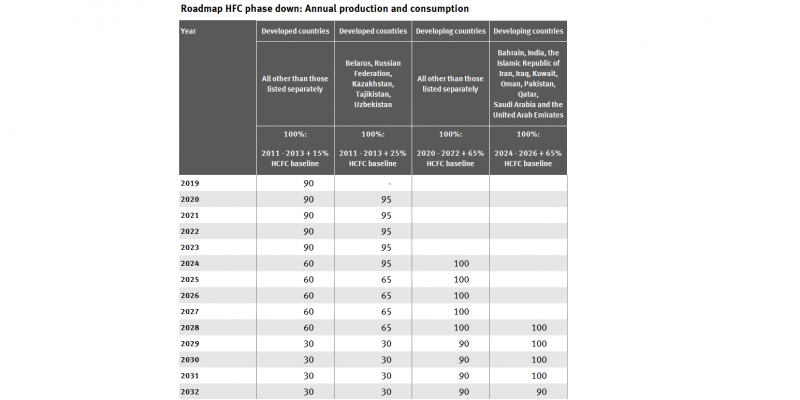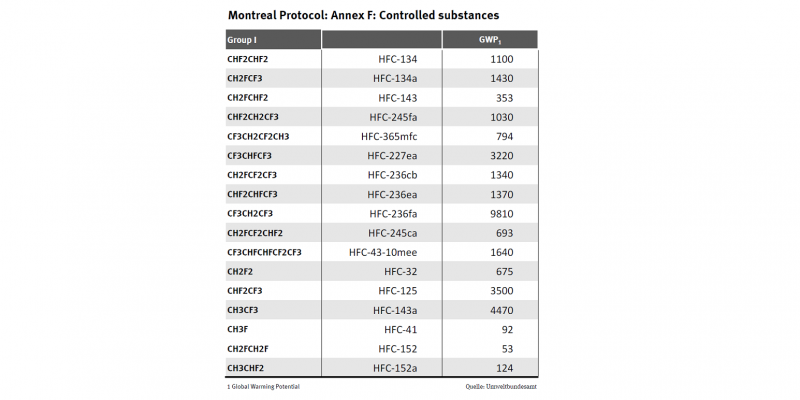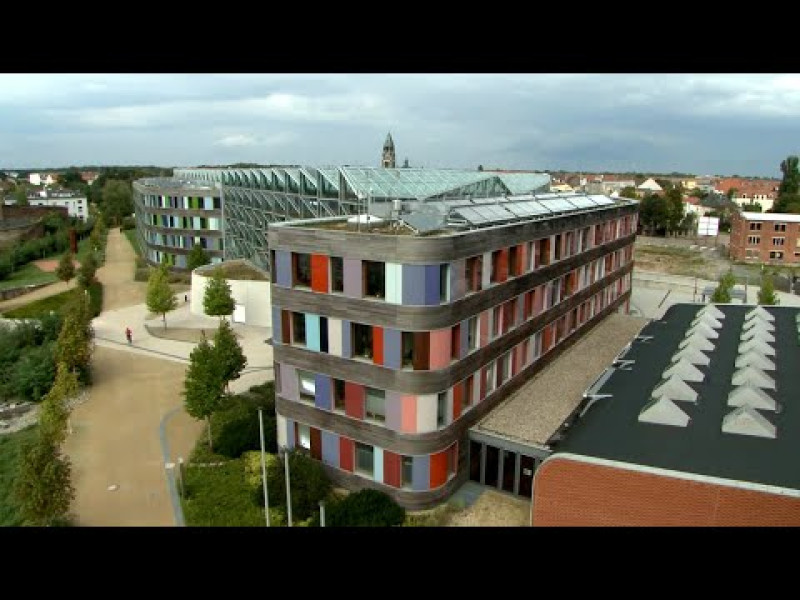International community decides first steps towards a phase-down of climate-damaging substances of particular concern: hydrofluorocarbons (HFCs)
Many years of negotiations culminated on the night of 15 October 2016: the Parties to the Montreal Protocol on Substances that Deplete the Ozone Layer agreed on a roadmap to phase down HFCs. This substance group, which was initially used as an alternative to ozone-depleting substances (ODS) like chlorofluorocarbons (CFCs) and hydrochlorofluorocarbons (HCFCs), can be replaced by much more climate-friendly substances. The agreement paves the way to a globally binding regulation. The EU had already introduced corresponding regulations in 2014.
The Kigali (Rwanda) Amendment requires developed and developing countries – to varying extents – to first freeze the production and use of HFCs and follow up with reductions in the subsequent years (HFC phase down). Whereas developed countries must start with a freeze in 2019, developing countries have more time to implement appropriate measures. The Amendment is four-tiered because some of the developed and developing countries have been granted longer time horizons for reduction. The developed countries are also required to support developing countries with additional funds from the Multilateral Fund for the Implementation of the Montreal Protocol. The Parties must now look to sustainable alternatives in order to protect the environment and climate.
EU Regulation on fluorinated greenhouse gases
From 11 March 2024 the placing on the market and use of fluorinated greenhouse gases (F-gases) within the EU has to follow the rules given in Regulation (EU) 2024/573. This Regulation has repealed the Regulation (EU) 517/2014.
Since the entry into force of the new EU F-Gas Regulation 2024/573, a licence is required for the import and export of the substances listed in Annexes I - III of the Regulation as well as products and equipment containing these substances. This is independent of the quantity of substances. The licence is issued by the European Commission, which requires registration in the F-Gas Portal.
The quantities of hydrofluorocarbons (HFCs) placed on the market in the EU will continue to be gradually reduced, and from 2050 the permitted quantity will be set to zero. For more information click on EU Regulation concerning fluorinated greenhouse gases.
Climate protection and fluorinated greenhouse gases (F-gases)
The effects of climate change can be observed in virtually every corner of the globe nowadays. Hence climate protection is one of the most serious ecological and economic challenges now facing the human race. The Kyoto Protocol, which is the most important and most prominent climate milestone to date, covers fluorinated greenhouse gases (F-gases) owing to their high global warming potential (GWP). The Global Warming Potential (GWP) is a measure of the climate effectiveness of greenhouse gases compared to CO2 as a reference substance (GWP = 1) and is usually considered over a period of 100 years. In the context of the Framework Convention on Climate Change, the international community has agreed to use the GWP values of the IPCC 's Fifth Assessment Report. The GWP values of F-gases are up to 23,500 times higher than those of CO2.
Impact of F-gases
Whereas classic greenhouse gases are for the most part released as undesirable byproducts of processes such as fossil fuel combustion, most fluorinated greenhouse gases are manufactured and used for specific purposes. Nowadays they are used in much the same manner as used to be the case for ozone depleting fully halogenated CFCs and halons.
F-gases are responsible for around 1.3 percent of the worldwide greenhouse effect (2004 statistics). According to a 2010 UBA study, by 2050 F-Gas emissions would have had a share of 7.9 percent of direct worldwide CO2 emissions without the Kigali Amendment.
Fluorinated greenhouse gases are mainly used nowadays as refrigerants, aerosol propellants, foam and insulation blowing agents, and fire extinguishing agents. In the interest of reducing emissions from these substances, apart from technical measures it is above all necessary to introduce targeted substitute agents or alternative technologies. This is the starting point of Regulation (EU) No 517/2014 on fluorinated greenhouse gases as well as Directive 2006/40/EC relating to emissions from air-conditioning systems in motor vehicles.
Fully halogenated CFCs and HCFCs
Fully halogenated CFCs and HCFCs were once widely used for myriad purposes owing to their technical properties and their non-flammability, while a number of other ozone depleting substances such as carbon tetrachloride were used by laboratories and for other specific applications.
When the ozone depletion potential of these substances came to light, the international community adopted the Montreal Protocol in 1987 and through it gradually implemented a globally applicable schedule for phasing out the production and use of ozone-depleting substances. The report "Scientific Assessment of Ozone Depletion: 2022" concludes: "The Antarctic ozone hole is expected to gradually close, with springtime total column ozone returning to 1980 values shortly after mid-century (about 2065)."
Perfluorocarbons and hydrofluorocarbons have been used as alternatives for many applications. While the substances of this group do not deplete the ozone layer because they contain no chlorine, some of them have a non-negligible global warming potential. The Scientific Assessment Panel (SAP) report from 2014 warned that the climate benefits of the Montreal Protocol could have been significantly offset by projected emissions of hydrofluorocarbons (HFCs) over the next decades. This scenario is avoided as a result of the HFC phase down stipulated in Kigali.
Halons
Halons are organic compounds that are derived from methane and ethane and that contain bromine in their molecular structure. They were once used as an extinguishing agent in fire extinguishers. Like fluorinated hydrocarbons, halons deplete the ozone layer, but by a factor exceeding one to ten relative to hydrochlorofluorocarbons (HCFCs).
 Click to enlarge
Click to enlarge


